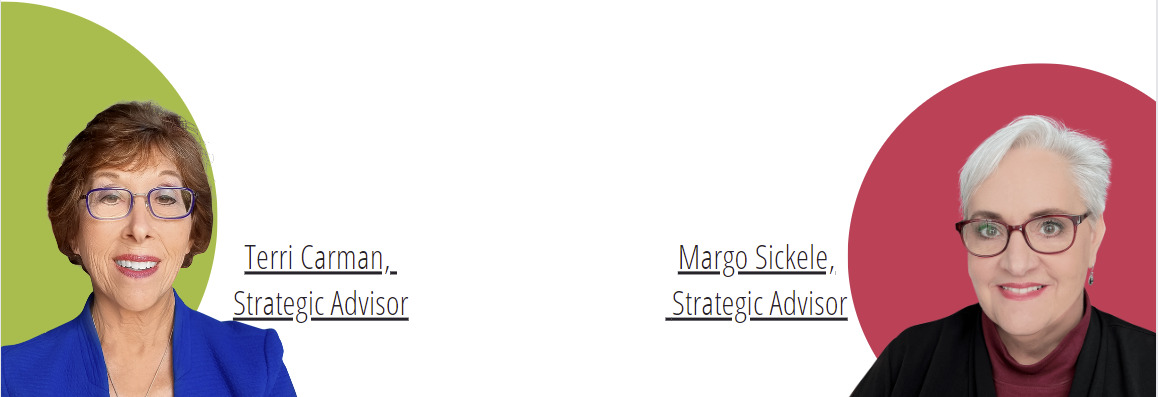Anyone who has ever worked in or served a school understands that school politics are a real thing . . . and can add complexity to an already complex system. (See our second post in this series). The media has highlighted or sensationalized things like hostile board meetings with angry parents, severe punishments cast upon students by staff, teacher union strikes in front of school buildings, etc. In addition, decisions about school curriculum content are becoming increasingly more controversial (book banning and critical race theory, to name a few). These examples shed some light on the tension that exists with various players in the educational system. However, the relational strife between interest groups cuts even deeper than what most average Americans might think.
When we consider some of the points we made in our first and second blogs, it’s no wonder that the vast majority of people have strong opinions about what should happen in schools, and that it has become quite political. We even celebrated the passing of the 2001 legislation known as No Child Left Behind (NCLB), which updated the Elementary and Secondary Education Act (ESEA) of 1965 as a non-partisan bill. This “marked an unprecedented extension of federal authority over states and local schools”.
The school work environment is one of the most human-resourced civic entities that exist in our society. Not only are hundreds of humans employed and asked to work together (consider how that goes in your workplace situation), these humans serve little humans who are also attached to other humans that have a profound investment in, well, everything. It is actually quite the accomplishment when things go well inside a school!
To illustrate the concept of the overlapping human resources, we use the example of a typical school district. There are usually six subsystems of humans within a single school district. Each of these subsystems we will call a boundary- thanks to the late Patrick Dolan. These boundaries play a unique and essential role within the larger system.
Boundary 1: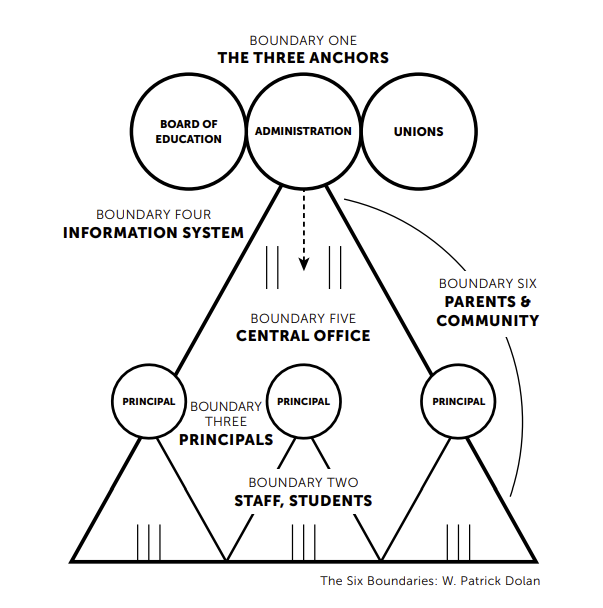
The Three “Anchors” [which represent the Board of Education or Charter Management, the Superintendent and Administrative Cabinet, and the Executive Council of the Union(s).]
Boundary 2:
The Teachers, Support Staff and Students
Boundary 3:
The Principals
Boundary 4:
The Information System
Boundary 5:
The Central Office and Specialists
Boundary 6:
The External Environment, which includes Parents and Community
Download the video and full Boundary Audit Rubric: bit.ly/2KT8XLV
The central idea of systems theory is that the Six Boundaries are highly interconnected. This means that if we want to move any of the six, we must move the whole system. Each of the Six Boundaries represents a significant element or subsystem of the larger system. Any significant change to one boundary means a significant change for every other part. That makes the process of change highly complex and resistant. It also means we can create considerable torque on tough systems. If our tactics are consistent at each boundary, then the pressure on one place will create pressures elsewhere. It is a source of powerful energy because pressure applied at one boundary can dislodge another resistant boundary. However, it is often political influence on public education that contributes to the boundaries feeling torque, but each boundary is pushed in different directions, making real movement forward increasingly more difficult.
Organizational change is hardly easy, even for those schools or districts best prepared to attempt such change. Change of this magnitude represents an organizational commitment to difficult, sustained, systemic work over many years. CEC seeks to provide the assistance to schools, districts and states to both build the collaborative structures and cultures needed for learning success and to bring to those cultures and structures the best in effective practices and impactful educational research.
By far, the best process to achieve any sustainable change in a complex system like a school district, would be to explore the possibilities together in a way that builds a shared vision and deep commitment. There is a need to build district and site-level reflective structures that enable key stakeholder groups in the system to listen and learn together. This involves creating vertical and horizontal communication and focused sharing on how best to support and sustain high quality teaching and learning in classrooms and schools through a culture of collaboration. By consistently building and pursuing continuous improvement through the support of collaborative relationships among teachers, school and district administrators, school board members, union leaders, and community leaders, all levels of a school system (each of the six boundaries), can build movement toward the same goal.
When systems develop and sustain distributive and collaborative practices with shared decision making, it allows parties to identify multiple ways to satisfy interests and to solve problems creatively, especially when it comes to potentially controversial topics. These practices, when applied in and between each stakeholder group, can lead to the torque that will move multiple boundaries forward in a systemic, sustained, effective, and efficient way.
When it comes to collaboration, we see evidence of its effectiveness in all facets of education. In 2011, Bluestone and Kochan developed a process of collaborative decision making in labor-management bargaining, which focused on “interest-based” decisions instead of a “win-lose” contract negotiation process, which has been successfully used in a large number of school systems. This process exemplifies the power of collaboration and problem solving that creates a system allowing members of Boundary 1 to move forward together. This work led Bluestone and Kochan to recommend that day-to-day responsibility for improvement in school outcomes be shared among principals and teachers. Teacher representatives at each school site would be part of a continuous problem-solving and joint decision-making process.
More examples: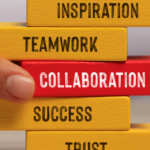
- The National PTA (Parent Teacher Association) lists their first value as “Collaboration: We will work in partnership with a wide array of individuals and organizations to broaden and enhance our ability to serve and advocate for all children and families.” This organization embraces the power of collaboration among and between all stakeholders of the educational system.
- In a 2004 ASCD publication, Rick DuFour, arguably the “father” of PLCs (Professional Learning Communities) identifies one of the 4 “Big Ideas” of PLCS as “A Culture of Collaboration”. He says, “Educators who are building a PLC recognize that they must work together to achieve their collective purpose of learning for all. Despite compelling evidence indicating that working collaboratively represents best practices, teachers in many schools continue to work in isolation.” Teacher collaboration is foundational to student learning and success in school.
- In 2019, James Hilton Harrell, in Edutopia, found that “school leaders who form communities of practice are empowered to address challenges in their district.” Principals who collaborate are more effective than those who don’t.
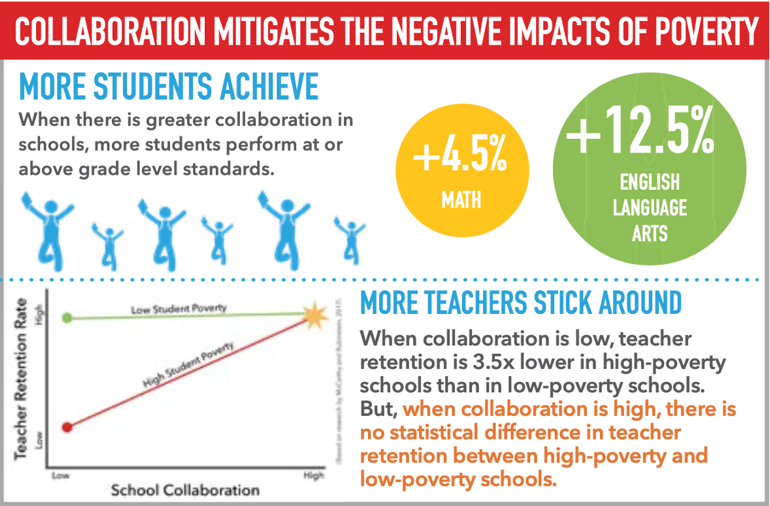
There are no generic patterns, at either system or site levels, of collaboration due to geography, policy climate or nature of the partners, which make examples “unique and localized.” Yet, research across industries in multiple sectors and nations has long established that, when employees are included in planning, problem solving, and decision making with their managers; their performance and productivity increases.
Bryk and Schneider explore the extent to which social trust is essential for meaningful school improvement. Social or “relational” trust is based on an “interrelated set of mutual dependencies … embedded within the social exchanges in any school community.” Leis, Rimm-Kaufmann, et.al, found that research from the past two decades identifies relational trust as a key factor in school reform efforts. Trust between teachers and their principal (teacher-principal trust) and teachers and their colleagues (teacher-teacher trust) are particularly important. However, there has not been conclusive research to demonstrate the positive relationship between labor-management collaboration and increased student learning - until recently. In their investigation of the labor–management partnership in the ABC Unified School District in California, Rubinstein and McCarthy definitively find that:
- Formal partnerships help improve student performance.
- Partnerships lead to more extensive communication between teachers.
- More extensive communication improves student performance.
- Partnership leads to more frequent and informal communication between union representatives and principals.
Undergirding the Unifying Framework for Change further, Rubinstein and McCarthy conclude that their study contributes to “our understanding of the value that union-management partnerships can bring to organizational performance by creating a positive climate for teacher collaboration, which leads to innovation and an infrastructure for problem solving.” That is, labor-management collaboration is what Rubinstein and McCarthy call an “institutional antecedent” to the professional collaboration that provides a pathway toward a transformation of the teaching profession.
One thing we can all agree upon is that we want our schools to be effective and successful in preparing our children for their futures. While we don’t all agree on the way to do that, through collaborative discussion and work, we can continually improve our effectiveness by aligning the school/district organization.
It is CEC’s strongly held belief that such organizational change is greatly needed, requiring a depth and breadth of knowledge and experience in student learning research, assessment practices, pedagogy, shared leadership models, and labor-management collaboration. Each player in the system brings expertise in their own areas to the table, and it is through intentional, significant collaboration that the system can move forward together and grow in a meaningful way.
All of these components, in combination, are necessary to bring about continuous improvement in student learning such that all students can be empowered through their learning. When we create collaborative partnerships between all stakeholders (labor and management, school board and administration, administration and teachers, etc.), we can begin to develop the strong forward movement in Boundary 1, and even in Boundary 2, that can create the energy to affect other boundaries in moving forward together. Once that movement takes hold and builds a common direction we can then address the most complex of the boundaries, Boundary 6, the external players.
We encourage you to consider the following:
- What do you know about what makes for success in modern day schooling? To what extent are you using student voice in modern school design and decision-making?
- How are you continuously learning about school system issues that go beyond your personal experiences?
- Are you listening and learning from all stakeholders before making decisions?
- Are you advocating for appropriate support and changes at the state and federal level?
Interested in delving deeper into this topic? CEC will be offering an online professional learning course and virtual networking opportunity later this year that will connect district leaders. Learn more about working with all the subsystems of players in your district to increase achievement and satisfaction with the school/district. Share and explore with others successful strategies and structures that are being used to create shared visions and decision-making.
